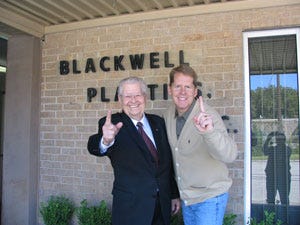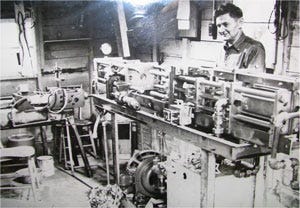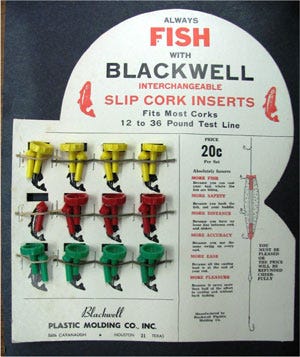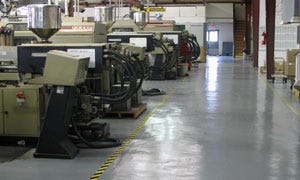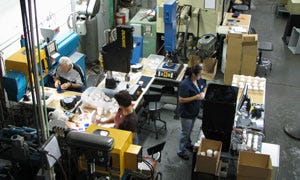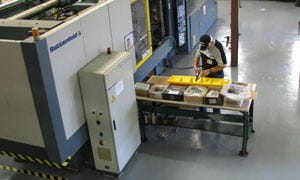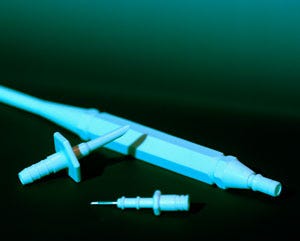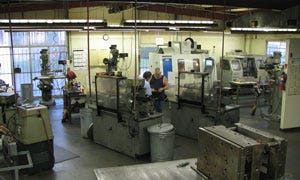Plant Tour: Seven decades of custom molding and counting
Just back to Houston after serving in the Air Force during World War II, a 21-year-old L.D. Blackwell had to lobby his congressman for a veteran's exemption to buy an injection molding machine.
June 9, 2010
Just back to Houston after serving in the Air Force during World War II, a 21-year-old L.D. Blackwell had to lobby his congressman for a veteran's exemption to buy an injection molding machine.
In 1946, it was still exceedingly difficult to procure much of anything in post-war America, but Blackwell's request was granted and he promptly spent $10,000 on a 250-ton HPM, launching himself and his company into the emerging world of custom injection molding. That industry would shape his life in the intervening years and, even today at 85, it continues to capture his imagination. "I've just had fun all my life," Blackwell says. "For 71 years I've been doing this, and it has been kind of fun seeing all the new things."
|
Founded in 1939, the company is located just south of the University of Houston. |
|
Blackwell Plastics founder L.D. Blackwell (left) and company president Jeff Applegate stand outside the molder’s main office. |
|
L.D. Blackwell’s father, L.A. Blackwell, poses in front of the plunger-style machine he conceived with his son. L.A. passed away while L.D. served in WWII, but his son would go on to complete the machine. |
|
These adjustable floats for fishing invented by L.A. Blackwell pushed father and son into the newly forming injection molding industry. |
|
Energy-efficient Negri Bossi machines dominate Blackwell Plastics’ shop floor. |
|
This cell creates a finished plumbing device, which requires a seal test. A diaphragm is spinwelded into a housing. |
|
A Blackwell Plastics employee handles a part molded for the railroad industry. |
|
Developed for cardiac surgeon pioneer Denton Cooley nearly 40 years ago, this “blood sucker” is used in open heart surgery and is still molded by Blackwell. |
|
At one time used for mold production, Blackwell Plastics’ toolroom now primarily repairs, maintains, and modifies molds. |
Originally opened with his father, L.A. Blackwell, in 1939, the company would grow along with plastics and molding, tracking the myriad changes in both. One common theme over its seven decades has been invention. A new and growing class of materials, plastics sparked the creative ingenuity of inventors everywhere, and in addition to its own advances, Blackwell Plastics helped many of these innovators take napkin sketches and crude prototypes through to polished products and commercial success.
The invention that initially launched the company came from L.D.'s father, an auto mechanic who also fished to supplement his income and help support his family. L.A. had created a sliding float-a fishing device that would allow anglers to set their lines at different depths. Initially milled on a lathe from wood, it was L.D. who, looking at a new plastic toothbrush, wondered aloud to his father whether the float could be fabricated from the artificial material.
Father and son would then go about constructing their own plunger-style press to mold the floats, and while his dad, a World War I veteran, died before the machine was completed, L.D. would finish their work. "We sold a lot of [the floats]," Blackwell says. "In fact, that's how we made a living for many years, just making those little inserts, and they were selling all over the country."
A lifetime in plastics
From a conference room in the original 6000-ft2 building (the company now covers around 90,000 ft2 spread among three buildings), Blackwell and Blackwell Plastics president Jeff Applegate discuss the company's past, present, and future. On three walls surrounding the conference table, parts, products, and pictures from that past serve as ready props to display the truly eclectic problems the company has solved.
Everything from collaborating with pioneer cardiac surgeon Michael DeBakey to develop the first bypass heart pump for open-heart surgery, to sensors worn by the first astronauts to enter space, to the first Weed Eater adorn the walls or rest on shelves. Intermittently, the shop floor, which is a door and short corridor away, can be heard in the distance, churning out new parts to potentially decorate the walls tomorrow.
It's cliché to say that every part has a story, but in the case of Blackwell Plastics it's truly the case, and over 70-plus years, a remarkable anthology of injection molding tales has been amassed. The yellow and green Weed Eater (string grass trimmer, to those unfamiliar) that hangs on the wall originally came to Blackwell Plastics in the early 1970s in the hands of an eager inventor as a set of handlebars with a Briggs & Stratton engine at one end and a wooden disc with small nylon strings coming off at the other end. After some effort, its creator, George Ballas, managed to start the device in front of the plant and began trimming grass for Blackwell. Ballas told a skeptical Blackwell his intent for the unwieldy device, and asked him what he should do next.
"I say, 'You've got to have a mold,'" Blackwell recalls, "and he says, 'Well what's a mold? How much do they cost?'" Showing Ballas several molds and describing their fabrication and price tag, Blackwell hoped to discourage the inventor. "Your life savings can end up in a pile of rusty iron and neither of us makes money that way," Blackwell remembers telling Ballas, but Ballas persisted. When he asked for a quote, Blackwell threw out a number he figured would be a conversation ender: $15,000. "[Ballas] said, 'Oh, OK,' and he pulls out a dirty old check. First damn day he wrote me a check, and I thought, 'What am I gonna do?' Called my bluff, I guess."
In time, Ballas and Blackwell would mold parts for a million Weed Eaters, eventually selling the entire company, in which Blackwell had a stake, to Emerson Electric.
Diversity weathers the storms
As we leave the conference room and step into the molding/assembly area, the company's customer diversity is immediately evident on its 30 machines, which range in tonnage from 22-550 with up to 60-oz shots possible. Those machines, which are largely Negri Bossi, are not only creating different parts, but also molding components for completely different industries. In succession, we see the molding of a plumbing device, a wet-wipe lid, an automotive part to prevent hot wiring, a frame for grocery cart advertisements, a safety device for railroads, a blood type test, and a toothbrush.
"All my life we've had an extremely diversified business," Blackwell says, "which has enabled us to go through periods of ups and downs in the plastics industry." Over the last two years, as the global economy slumped, its reverberations didn't spare Blackwell Plastics, but the company, as it has for seven decades, persevered. "We felt the slump last year-don't think we didn't, but we have gone through these for many years," Blackwell says. "All my life I've seen them-ups and downs-and we were able to go through that one because we had some diversification. When some products go down, others go up, even in an economic slump."
According to Applegate, Blackwell Plastics' top 10 customers are in 10 completely different industries, with no single client generating more than 10% of its business. Applegate, who joined Blackwell Plastics in 2003, says the company's current strategy is in response to a changing business environment.
"The injection molding business has gone through a number of evolutions," Applegate says, "from regional/small/custom to global, serving the big OEMs, and now it has kind of come back to where it truly is a regional business service where you're close to your customer and you know your customers." Last year, when production slowed due to the economy, Blackwell Plastics not only invested in its equipment, making upgrades, but also revamped its website to support its regional focus. According to Applegate, 80% of the company's Web traffic comes from within a range of 300 miles.
In addition to targeting different markets, the company goes after those markets with different technologies, offering pipe and profile extrusion capabilities, which were originally installed in the late 1950s, in addition to molding technology. In a separate building, the company runs five extrusion lines, ranging from 3/4-21/2 inches, plus an additional lab line. On this day, a tube for oil exploration is being run.
The same building that houses extrusion also has the company's toolroom. Originally designed to build molds, the room is now primarily used for tool repair, maintenance, and modifications. The final building onsite would be called a warehouse by most, but Applegate and Blackwell stress it's a "staging area," which houses raw materials and finished parts. Currently being staged is a large open container that will serve as a feeding bucket for a horse. The design prevents spills, so horses can't tip the container and end up consuming dirt as well as feed, while also pacing how fast the animals eat. It's the eighth part we've seen and the eighth different end market.
Walking plastics encyclopedia
While Blackwell Plastics has all the technological advances you'd expect to see in an established, successful operation, its best asset may be the institutional knowledge of its owner, amassed over a lifetime in plastics. Admitting that many nights stretched into the next day, reading technical articles and journals until one in the morning, Blackwell says his library of engineering books alone could fill the conference room we're sitting in.
"You won't find a more well-read guy than L.D.," Applegate says, "and as far as being self-taught in engineering, in business law, in accounting . . . he's forgotten more than I'll ever know. He's amazing."
In addition to book smarts, Blackwell brings 70-plus years of hands-on manufacturing expertise to bear on the problems the company must solve today. "[Molders] didn't have SolidWorks, core pulls, collapsible cores, CNC machines-things that are standard in the industry," Applegate says, "and he had these really creative ways to get the same things done. With this modern technology, we have all these tools, but in our low-volume high mix, sometimes we have to come back to these innovative techniques of the early days."
Running the company under 13 different U.S. presidents, the country and the industry have seen sweeping change since Blackwell and his father first began building that plunger-style press to mold fishing floats. But as radically different as today's landscape is, Blackwell is convinced it still holds a place for his company. "There will always be a need for companies like this," Blackwell says. "That's why we can't be obsoleted, in my opinion."
Vital Stats: Blackwell Plastics Inc., Houston, TX
Facility size: Approximately 90,000 ft2
Annual sales: $6 million-$8 million
Markets served: Energy, life science, aerospace, food and beverage, industrial, electronics
Parts produced: 6.5 million plus more than 2.0 million ft of extrusion
Materials processed: ABS, acetal, acrylic, nylon, PC, PE, PP, polyesters, PSU, PPS, urethane, PVC, and most engineered resins
Resin consumption: More than 1 million lb/year
No. of employees: 70
Shifts: Three
Molding machines: 30, 22-600 tons; Battenfeld, Boy, Negri Bossi (plus five extrusion lines)
Molding technology: Insert molding, overmolding, with a 
specialty in thick-section parts with no voids
Secondary operations: Milling, turning, welding (sonic, spin, and solvent), heatstaking, assembly, packaging, custom automation
Other services: Logistics, program management
Internal moldmaking: Yes
Quality: Operate to ISO 9001:2008 standards, registered with FDA, NSF, ASSE
Web extra: Now that's a marketing video
Crank up the volume and watch Blackwell Plastics in motion.
Contact information
Jeff Applegate | (713) 643-6577
www.blackwellplastics.com
About the Author(s)
You May Also Like

